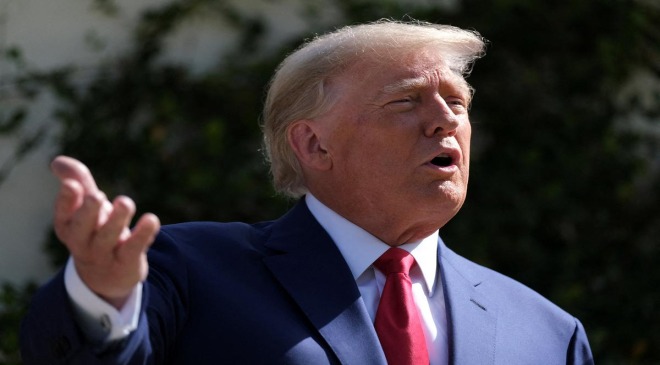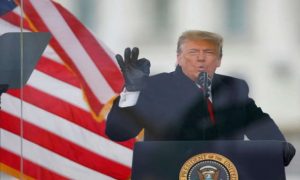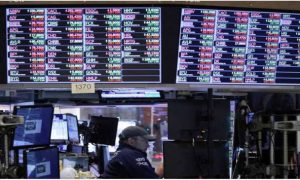Democrats are casting the economy under Donald Trump as a Dickensian portrait of inequality, while he claims it was the best in history. The reality is that most Americans benefited from the rising Trump tide before Covid, but they also would have fared better without his tariffs. This heralds the fight over the next phase of Trumponomics if he wins a second term.
The centerpiece of the Trump economic agenda was his 2017 tax reform and deregulation. Mr. Trump and the GOP Congress slashed the corporate tax rate to 21% from 35% and adopted a territorial system that doesn’t tax foreign income. This eliminated a large incentive for relocating offshore and the penalty for bringing overseas cash back to the U.S.
Also Read– A dark and dangerous new chapter for American politics
In return, companies were required to pay a one-time tax on foreign earnings. The law spurred U.S. multinationals in 2018 to repatriate three quarters of the $1 trillion they held abroad. Democrats say companies spent the cash on share buybacks, but the point was to bring the money back to invest in America in whatever form. Buybacks are a form of dividend.
Many companies also rewarded workers with higher pay. Some plowed their repatriated earnings into new equipment, which benefited from the law’s full expensing for capital investment. A Federal Reserve study found that the 15 companies that had held the most cash overseas increased investment more than those with less.
Read More:- John Roberts has done what the Founders never could have imagined
The Trump deregulation may have been even more significant in reducing business costs and unleashing investment. The Competitive Enterprise Institute’s Wayne Crews calculates that the Federal Register in 2017 finished with the fewest pages since 1993. Mr. Trump’s first three years in office produced record-low levels of significant regulations. While such rules increased in 2020, many rolled back Obama-era regulations.
Mr. Trump’s tax and regulatory policies lifted investment and the economy, which had slowed in the last two years of the Obama presidency. Business investment during Mr. Trump’s first three years more than doubled while average annual GDP growth increased 0.7 percentage points. Stronger growth produced a tighter labor market and higher wages that benefited lower-income workers.
Read More:- Radio station ‘parts ways’ with host after admitting White House gave her questions before Biden interview
Real average hourly wages adjusted for inflation climbed 2.9% between January 2017 and 2020, a sharp contrast to the 1.9% decline since January 2021. While higher earners did well, so did the poor. The share of Americans earning more than $200,000 (adjusted for inflation) increased by roughly a quarter while the proportion making less than $35,000 fell by about 10%.
Alas, the Trump mini-boom was tempered by the economic uncertainty and costs of his tariffs that hit friendly nations and adversaries alike. These included 25% duties on steel and 10% on aluminum, as well as levies on washing machines, solar panels and an array of Chinese goods that raised costs for U.S. businesses and consumers. “Tariff man” forgot about the common man.
The Tax Foundation estimated that the Trump tariffs cost American households more than $625 annually. A 2019 study by Fed economists looked at two waves of trade policy “shock,” first in 2018 and then in the first half of 2019, and estimated the impact reduced GDP growth by about one percentage point. Tariffs contributed to the slowing economy and business investment late in 2019, which then plunged at the onset of the pandemic.
Read More:- The world must prepare for President Michelle Obama
Mr. Trump and Congress responded to Covid with a $2 trillion relief bill, which was perhaps understandable given the panic in March 2020. But after shutting down the economy on the advice of Anthony Fauci, Mr. Trump too easily went along with Democratic spending priorities, including enhanced unemployment benefits that paid workers more not to work.
He also unilaterally extended Congress’s short-term student loan payment pause and eviction moratorium on dubious legal authority, which set the stage for Mr. Biden to do so repeatedly. In December Mr. Trump prodded Congress to spend another $900 billion, which was counterproductive as the economy was fast recovering. Mr. Trump is no fiscal conservative, and one risk during a second term is that Democrats cajole him into expanding entitlements, especially if there’s a recession.
Read More:- Supreme Court opinion conferring broad immunity could embolden Trump as he seeks to return to power
Mr. Trump’s plans for the second term are unclear and sometimes contradictory. On the one hand, he wants to extend the 2017 tax rates that expire at the end of 2025. This is a big advantage over President Biden. But Mr. Trump is also proposing a 10% tariff on all imports that the Tax Foundation says would shrink the economy by 1.1% and threaten more than 825,000 U.S. jobs.
He’s also promising more deregulation and a rollback of Mr. Biden’s green new deal, which would address the Biden-era’s gross misallocation of capital. But his new running mate J.D. Vance has said he doesn’t mind raising taxes on business and has endorsed Biden’s hyper-regulator Lina Khan.
Another wild card is monetary policy. A victorious Mr. Trump would have a mandate to reduce inflation. But as a real-estate baron, Mr. Trump has always favored low interest rates. This makes his choice of a strong-willed and independent Federal Reserve Chair crucial.
Read More:- Mark Cuban’s Trump, Biden Election Comment Goes Viral
In 2017 Mr. Trump came to office with a GOP Congress that had a well-developed policy agenda on taxes and deregulation. Mr. Trump went along and it paid off. But the current GOP Congress is an intellectual mess on economics.
This means Mr. Trump will put his own stamp on policy from day one. His White House will be an almost daily jump ball between free-market advisers and the new GOP statists and protectionists. A second Trump term promises to be better than what Bidenomics has wrought, but it isn’t risk-free.



































